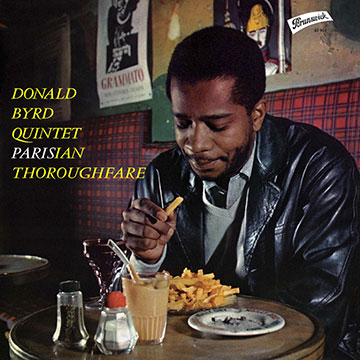Paris Jazz Corner
shops
5 rue de navarre
75005 Paris
T: (+33) 1 43 36 78 92
contact@parisjazzcorner.com
Agency open from
tuesdays to saturday
from 12.00 AM to 8.00 PM
27 place de la libération
30250 Sommières
T : (+33) 4 66 35 42 83
contact@parisjazzcorner.com
Agency open on:
Saturday from 12.00 AM to 7.00 PM
or by appointment
Rechercher

Donald Byrd (trumpet)
"Parisian thoroughfare"
Brunswick 1958 (réf. 87 904 -)
Featuring :
Donald Byrd (trumpet), Walter Jr. Davis (piano), Bobby Jaspar (saxophone), Art Taylor (drums), Doug Watkins (bass)
33rpm, stereo,
second hand, 30.00 €
[35.40 US$, 3,891.00 ¥]
2014 French reissue Sam records- limited edition
Record's condition : S
Cover's condition : S
> See pictures about : Donald Byrd
> See pictures about : Walter Jr. Davis
> See pictures about : Bobby Jaspar
At the beginning of 1956, he’d decided to try his luck in the United States; J.J. Johnson had hired him, and then Miles Davis (for a brief spell) before Donald Byrd brought him into his own group. After appearing in Cannes (in the sun) and Knokke-le-Zoute (a much smaller audience) for almost three months, the Donald Byrd Quintet settled down for the autumn in one of the capital’s top jazz spots, the Chat Qui Pêche on the Rue de la Huchette. “In that tiny room,” wrote Frank Ténot, “where the owner used to bump into the soloists by accident when she was serving her customers, the music they played was hot, and always surprising.” To crown a tour that had been extremely satisfying for everyone, a concert at the Olympia theatre was organised (there were gigs there called “Jazz Wednesdays”). Byrd and Co. took things very seriously, even though they preserved the relaxed approach that their (relatively) long association now permitted: La Marseillaise, and And the angels sing are both present in the introduction to Parisian Thoroughfare played by the two horns. The latter then went on to imitate other horns, those of the cars on 52nd Street... However, when it came to Stardust, it was with all the seriousness in the world, almost in meditation in fact, that Donald Byrd improvised over the backing provided by just Walter Davis Jr. and Doug Watkins. Bobby Jaspar, of course, was marvellous. If he showed a marked obedience to Sonny Rollins, he still preserved, intact, the virtues of sobriety that prevented him falling into the trap of serving up torrents of notes in pieces taken at a rapid tempo (At This Time, for example). During the exchanges on Formidable, you’d be forgiven for saying that he gets the better of Donald Byrd. As for the complicity that reigned between the members of the rhythm section, it gave the formation a homogenous character that was very rare in a quintet. One can’t thank François Postif enough for taking the risk to release this concert at the time. Now, almost half a century later, one can only agree with Jazz Magazine’s critic on the subject of the Donald Byrd Quintet: “The only thing missing (…) was the consecration that a great concert in Paris would bring. They won that last battle with astounding brio in front of an audience of connoisseurs. There were many there who thought modern jazz had never been so well-served in Paris.”
Alain Tercinet
Recorded October 22, 1958, Olympia hall, Paris. Original LP issue: Brunswick 87 904.
Side A:
Salt Peanuts (D. Gillespie, K. Clarke) 2’15
Parisian Thoroughfare (B. Powell) 9’05
Stardust (M. Parish, H. Carmichael) 3’19
52nd Street Theme (T. Monk) 6’42
Side B:
At This Time (D. Byrd) 10’03
Formidable (W. Davis Jr.) 9’28
Two Bass Hit (D. Gillespie, J. Lewis) 2’56
Salt Peanuts reprise (D. Gillespie, K. Clarke) 2’15
Donald Byrd (Trumpet)
Bobby Jaspar (Flute, Tenor Saxophone) Walter Davis Jr. (Piano)
Doug Watkins (Bass)
Art Taylor (Drums)
. Each record has been visually checked to prevent defects.
• Re-mastered from the original master tapes.
• Limited edition 1000 copies.
• 180 gr vinyl pressed by Pallas in Germany.
• Facsimile reissue using the original cover art (front photo is lost).
• Double insert using an original photo by JP Leloir from 1958.
IMPORTANT: A slight distortion may appear on the piano or the drums. This defect, due to the poor quality of the master tapes, is impossible to erase without distorting the entire recording.
0 item in your basket
Agency open on: Saturday from 12.00 AM to 7.00 PM or by appointment
©parisjazzcorner.com 2015 | legals mentions | to contact us | top
